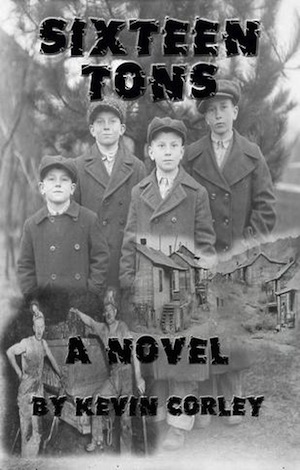
What does it take to bring a pot of water to boil, to light a lamp, to heat a home?
When read in light of this simple question, Kevin Corley’s 2014 novel Sixteen Tons, a Novel pushes us to interrogate the humanity of the U.S. dominant culture’s values as they have historically been realized in the way we organize our economy and the social relationships of production so we can produce goods and services to meet our basic collective needs, such as bringing the proverbial pot of water to boil. What stands out in Corley’s rich and intimate, yet epic, portrayal of working-class lives across generations as he narrates the larger history of class struggle in the U.S. coal industry from 1898 to 1948, is the sheer and constant violence and brutality workers and their families endured-and also engaged in. Indeed, in this sense, the work can be read as a novelistic counterpart to Louis Adamic’s 1934 history Dynamite: The Story of Class Violence in America, though Corley focuses exclusively on coal mines and really brings the history to life with well-developed characters across classes, as he explores in layered ways the social, psychological, and historical factors that condition character and behavior.
Sixteen Tons represents violent behavior on all sides, urging us to reflect on the circumstances in our class culture that foster brutality. The novel opens portraying the Virden Massacre of 1898 in which workers shot African Americans being brought in as strikebreakers and then moves through particularly bloody landmark moments in U.S. labor history in the coal industry, including the massacre of striking workers in Ludlow, Colorado in 1914, the Battles of Matewan and Blair Mountain in West Virginia in 1920 and 1921, the Herrin Massacre in Illinois in 1922, up through struggles in the 1930s when workers organized the Progressive Miners of America as an alternative union of John Lewis’s United Mine Workers union.
The violence is murderous, and it doesn’t simply punctuate this history; it pervades and indeed defines it. When reading the novel, I was reminded of Paula Gunn Allen’s characterizing of Native American women’s writing as a war literature that has “articulated and rendered the experience of being in a state of war for five hundred years,” even if “non-Indians are largely unconscious of this struggle.” Sixteen Tons, in its representation of the relentless violence of class struggle, particularly against workers and their families, underscores that we can also accurately characterize U.S. working-class literature as similarly rendering the experience of living in a constant state of war, of being constantly under attack. And, certainly, U.S. culture as a whole is “largely unconscious” of this fact and history. One character in the novel, in commenting on the Battle of Blair Mountain, comments, “Fifteen thousand of us there were, the biggest army on American soil since the War of Succession,” highlighting the magnitude and reality of this class war that rages on in our history and culture without acknowledgment for the most part. Part of Corley’s achievement is in making this class war visible in the most human of terms as we follow the lives of working-class families for the most part simply wanting to earn a living wage and live with and raise their families in loving and cooperative ways.
Corley’s representation of the Ludlow Massacre is particularly unrelenting, as we see the tent city where workers’ families live under fire from corporate-backed snipers and militia at all hours of the night, killing children and parents. Finally, the tent city is burned to the ground and the workers and their families are hunted. It is sheer brutality, and it makes us ask if this is really the best way we can devise for producing the energy to bring a pot of water to boil. Seriously?! As another character says, speaking of the mine bosses at Blair Mountain, ” . . . they’re just sleek, dignified church-going gentlemen who would rather pay fabulous sums to kill men for wanting to join a union than pay those same men for delving into the subterranean depths of the earth and producing the wealth for them.”
The novel makes visible and forces reflection on the murderous brutality towards workers, towards people generally, in our economic system designed to produce profit rather than meet human need. Typically, it is conceived that feudalism supposedly differs from capitalism in that it employs non-economic forms of coercion to extract value from workers while capitalism relies on impersonal market forces to determine wages and so forth. Sixteen Tons invites us to rethink capitalism by focusing on the naked and brute violence employed by capital to reduce wages and production costs at the expense of worker safety. And it asks us to imagine a better, a more humane way to bring the pot of water to boil.
Book review
Sixteen Tons, a Novel
Kevin Corley
Hardball Press, 2014, 388 pages/paperback












Comments